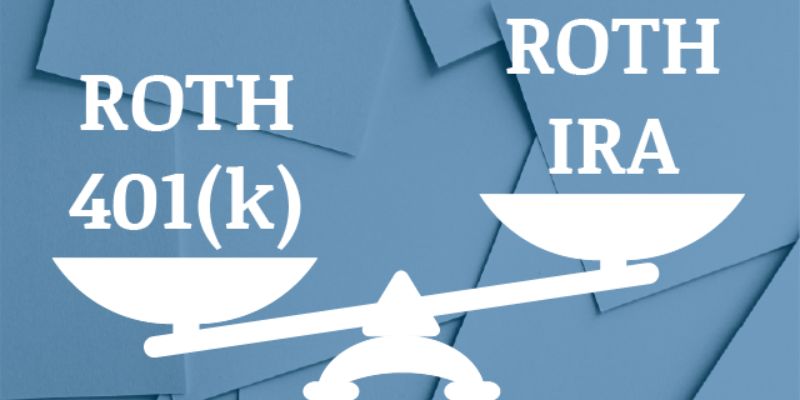Saving for retirement is a crucial aspect of financial planning, and two popular retirement savings options in the United States are the Roth IRA (Individual Retirement Account) and the 401(k) plan.
While both are designed to help individuals save for retirement, they have distinct features and advantages. In this detailed comparison, we'll explore the differences between Roth IRAs and 401(k) plans to help you make informed decisions about your retirement savings strategy.

What Are The Differences Between A Roth IRA And 401 K?
Individuals can save for retirement with Roth IRAs by transferring after-tax income into the account. Since you make contributions to this account after taxes, you are not immediately eligible for a tax deduction for your contributions.
Nonetheless, in retirement, eligible withdrawals from this account, including earnings, are tax-free. The IRS sets yearly contribution restrictions for Roth IRAs in addition to income eligibility limits.
Employees can contribute a percentage of their pre-tax salary to a retirement account through an employer-sponsored retirement savings plan, known as a 401(k) plan. Traditional 401(k) plan contributions are made using pre-tax money, which lowers your current taxable income and offers instant tax advantages.
In retirement, withdrawals from a typical 401(k) are subject to regular income tax. Employees can make after-tax contributions into a Roth 401(k) through some employers, which is comparable to a Roth IRA.
Why Is A Traditional 401k Better Than A Roth?
The decision between a regular and Roth 401(k) frequently comes down to current tax rates and anticipated future taxation. By lowering taxable income and putting you in a lower tax rate during your working years, a classic 401(k) offers immediate tax benefits.
Moreover, withdrawals from a standard 401(k) may be taxed at a reduced rate if you expect to be in a lower tax bracket in retirement. This is why those looking to reduce their current tax liability while gaining access to potentially reduced tax rates in retirement should consider a standard 401(k).
What Are The Contribution Limits For Roth IRA Versus 401(K)?
For 2024, the maximum contribution limit for a Roth IRA is $6,000 for individuals under 50 years old and $7,000 for those 50 and older (including catch-up contributions). Contribution limits may vary based on income and tax filing status.
On the other hand, for 2024, the maximum contribution limit for a 401(k) plan is $20,500 for individuals under 50 years old and $27,000 for those 50 and older (including catch-up contributions). Employer matching contributions do not count towards these limits.
Tax Treatment and Investment Options For Roth IRA versus 401(k):
Contributions to a Roth IRA are made with after-tax dollars, so there are no immediate tax benefits. Hence, qualified withdrawals, including earnings, are tax-free in retirement. This tax-free growth can provide significant long-term benefits, especially if you expect to be in a higher tax bracket in retirement. Conversely, contributions to a traditional 401(k) are made with pre-tax dollars, reducing your current taxable income.
While contributions provide immediate tax benefits, withdrawals in retirement are taxed as ordinary income. Roth 401(k) plans offer tax treatment similar to Roth IRAs, with after-tax contributions and tax-free withdrawals in retirement.
With an IRA account, investors have a wide range of investment options, including stocks, bonds, mutual funds, ETFs, and more. Investors have the flexibility to choose their investments based on their risk tolerance, investment goals, and time horizon.
In contrast, investment options within a 401(k) plan are typically limited to a selection of mutual funds, ETFs, or other investment vehicles chosen by the employer or plan administrator.
Why Is the Roth IRA better?
The Roth IRA stands out as a superior retirement savings option due to its unique tax advantages. By contributing after-tax dollars, your investments grow tax-free, offering significant long-term benefits.
Additionally, unlike traditional IRAs, where withdrawals are taxed as income in retirement, Roth withdrawals after age 59 are generally tax-free, providing greater flexibility and potential tax savings.
This tax-free growth potential, coupled with the ability to make penalty-free withdrawals, makes the Roth IRA an attractive choice for individuals seeking to maximize their retirement savings and minimize future tax liabilities.
Employer Matching Contributions:
Roth IRAs do not offer employer-matching contributions since they are individual retirement accounts. Contributions are solely made by the account holder, subject to annual contribution limits.
Many employers offer matching contributions as part of their 401(k) plans, providing additional retirement savings incentives. Employer matches vary widely and are often subject to a vesting schedule, which dictates when employees become entitled to the matched contributions.
Contributions to a Roth account can be withdrawn at any time without penalty, as they have already been taxed. However, withdrawals of earnings before age 59 may be subject to taxes and penalties unless they meet specific qualifying criteria, such as first-time home purchase or qualified education expenses.
Withdrawals from a traditional 401(k) before age 59 are generally subject to a 10% early withdrawal penalty in addition to income taxes.
Is Roth IRA Safe Or Risky?
While Roth IRAs come with inherent risks, they offer considerable potential for long-term growth. Market volatility and penalties for early withdrawals can lead to losses, highlighting the importance of prudent investment decisions. Contributing excessively or starting investments late may also pose risks.
However, despite these factors, these accounts remain a popular choice due to their tax advantages and potential for significant gains over time. While not without risk, careful planning, diversification, and a long-term investment horizon can mitigate potential downsides, making Roth IRAs a valuable component of a comprehensive retirement savings strategy.
Rollover Options and Required Minimum Distributions (RMDs):
Roth IRAs offer flexibility for rollovers from other retirement accounts, such as traditional IRAs or employer-sponsored retirement plans. Rollovers from traditional retirement accounts to a Roth IRA are subject to income tax in the year of the conversion.
Many 401(k) plans offer the option for participants to rollover funds into another employer-sponsored plan or an IRA upon leaving the company or retiring. Direct rollovers to this account may incur taxes on pre-tax contributions and earnings.
These accounts do not have required minimum distributions (RMDs) during the account holder's lifetime. This feature allows for greater flexibility in retirement planning and potential tax advantages for beneficiaries. Traditional 401(k) plans are subject to RMDs starting at age 72 (or age 70 if you reached 70 before January 1, 2020). Failure to take RMDs can result in substantial penalties from the IRS.
Conclusive Note:
Both Roth IRAs and 401(k) plans offer valuable retirement savings options, each with its advantages and considerations. Understanding the differences between these retirement vehicles can help you develop a comprehensive retirement savings strategy that aligns with your financial goals and objectives. Consulting with a financial advisor can provide personalized guidance based on your circumstances and retirement objectives.

Understanding Term Life Insurance

Roth IRA Versus 401(k): A Detailed Comparison

Best Midcap ETFs

All About Test Driving of a Car

Best Business Loans for Bad Credit

Taxes Must Be Filed by the 2022's End. What You Need to Know If You Still Haven't Filed

How to Claim Boyfriend/Girlfriend as a Dependent on Tax Return

How to Avoid Paying Taxes Double on Your Mutual Fund Investments

For What Length of Time Can a Boat Be Financed?

Ways to Refresh Your Budget for the New Year

What Happens When You Default On A Loan?

